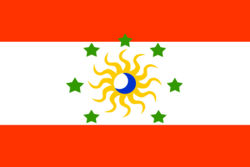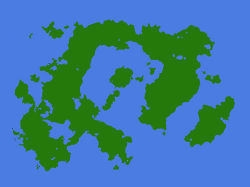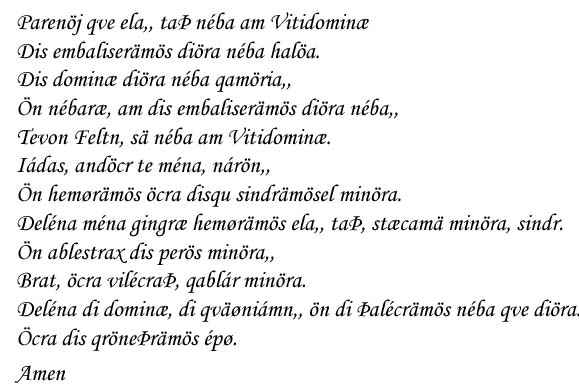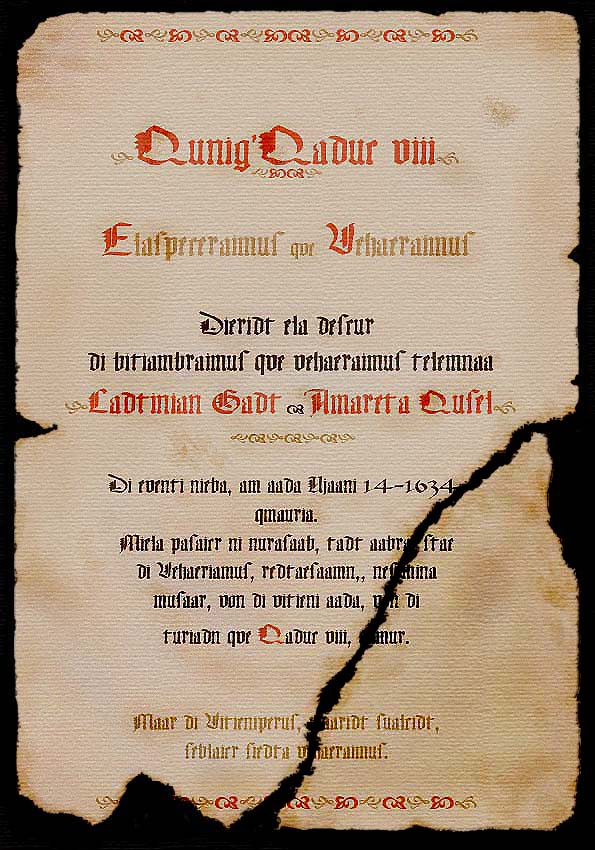Dalcurian language and basic history
The earliest form of Dalcurian language was developed as a religious tongue by a rather eccentric pagan king called Thadæus Thadurac (Dalcurian: þadæös þadörac) around 200 BC. The religion was a breakaway form of Paganism that was practiced throughout Europe around that time, and had thousands of followers, divided up into fellowships. Thadurac was the order's self appointed king, and highly revered among his followers. Although not fully substantiated, it's thought that he was a Carthaginan. Carthaginians were great seafarers and they capitalized on the trade of the Iberian silver and British tin. Thadurac had forged trade links as far as England, and was a highly respected Carthaginian councillor.
Thadurac, an eccentric to say the least, had studied language in Greece as the young scholar of a prominent Greek philosopher called Adaikos in 210 BC. He had learned many things whilst under the wing of Adaikos, including skills in economics and governing. These skills would eventualy stand him well when came to true power on the Dalcurian islands, bringing stability and order to his society, radicalizing even more his then worshipped religion with his own ideals and philosophies.
Around Thaduracs time, the Carthaginians wealth, mastery of trade and expansion along the Mediterranean coast towards Italy brought Carthage into direct confrontation with the newly rising power of Rome. Sensing invasion at the hands of the Romans, he fled Carthage to southern Ireland where he and 10,000 of his followers from across Europe merged with the Irish Celtic branch of the Thaduracian fellowship. Years earlier, he had sent one of his Iberian Celtic Fellowships to the Dalcurian Islands, after they [the islands] were given to him as a kingly gift from the Irish Celtic branch of the order. This Celtic Fellowship had utilised its mastery of hemp, and forged a trade link back to the Mediterranean as a result of Thadurac's strong influence in the region. Thadurac now sought to colonize the islands, and did so with gusto, enticing many more followers to join him from various European regions. He named the islands Þadöracia-Thaduracia, and by 180 BC, the population numbered in excess if 100,000. The now termed 'Thaduracians' had for many years been encouraged to use Thadurac's religious language, and with a new influx of followers, his conlang diversified into many dialects. However, the language would undergo many inevitable changes as a direct result of migrants bringing into it their own influences, and it took around 150 years for a standard form to emerge. It's this standard form that we now term 'Thaduracian' for historical purposes, and would last for approx another 150 years or so before its transition into 'Proto-Dalcurian' or 'Neo-Thaduracian' as it's sometimes refered to.
As the years of Thadurac’s reign went by, and indeed long after his reign, his religious language matured, and as it became more widely accepted, it became more advanced, forming small pockets of colloquial speech in many villages and towns. It spread out into the remaining fellowships of Western Europe, becoming ever more present in every day speech. The European factions of the fellowship would ultimately form their own dialects, which eventually substrated into the island's own dialect during the Pagan exodus of the 3rd and 4th centuries.
Though records and manuscripts are few, the early language itself appeared to have been very simple and mainly synthetic (since a word could be inflected for person, tense, number and modality). It's lexicon was perhaps around 500 base words, most verbs were inflected for person, number and tense (perhaps influenced by Latin), and it can be said that 'derivational synthesis' was frequently employed to create new words, long after Thadurac had died.
From the mid 3rd century, thousands of European pagans, not just Thaduracian pagans, migrated out of their homelands running from persecution, after the Roman Emperor Constans decreed that all pagan worship and sacrifice (even though Thaduracian Paganism did not practice sacrifice) should cease; warning those who still persisted in the practice of paganism with the threat of the death penalty. Many more found their way to Thaduracia, after Theodosius I officially declared Christianity as the official religion of the Roman Empire.
By this time, the Thaduarcian tongue had long been accepted as the main language of the island (although it wasn’t official), and having knowledge of Thaduracian meant integration into society was relatively easy for this new influx of Europeans. This exodus inevitably produced a myriad of dialects across the island, and brought into the language many loan words from the Germanic languages. Regional village dialects formed, though not drastically, as the settlers from various European regions tended to stick together in the same village or town.
Not only did the language take on new traits, but also Thaduracian society became more highly developed. Many large towns rose up across the island, and its first city was officially named as Calmania (dal: Qal’mánia) in 467. The main port in the southwest region of Halcarnia (Hal'qánia) became increasingly busier, largely due to the island’s geographical position. Ships coming from Africa would often make port there where goods would be bought, sold and bartered for. (From this era, a 'pidgin' form of Dalcurian formed among the traders, which would eventually come do dominate the area and became a 'superstratum'). The then leader, king Heldoch d’Calba II (dal: Heldø d’Qalba), established its first form of government with the aid of Roman Auxiliary defectors, which created a more centralized control over the towns, villages, and of course the economy.
In 512AD, Dalæth Curan (Dalcurian: DalæÞ Qöran) became Thaduracia’s youngest king at only 22 years of age. Like his great predecessor Thadurac, he was a very astute scholar. He had studied language and history, was fluent in Latin and Old English, and had studied the Celtic languages (by this time, a strong Irish Celtic society had formed in the northern region). He was extremely ambitious, and one of the first things he sought to do was to re-open the Mediterranean trade link that had been lost 150 years previously. The Mediterranean was a trade link that Thaduracia had followed for over 800 years, and the bulk of its hemp trade came from there. Even when the Romans captured the Carthaginian trading colonies along its coast (roughly 210 BC-Dalcuria had a huge export trade in tin with Carthage) trade only dwindled slightly. However, with the onset of Christianity into the Roman Empire, trade was banned by the Romans at the beginning of the 4th century after Theodosius I established Nicene Christianity as the official and, except for Judaism, only legal religion in the Roman Empire. He declared that Thaduracian Paganism, which by now had been dwindling in Europe for some years, was merely a cult, denouncing the Christian religion. Even though Thaduracia was not part of the Roman Empire, he conceived the notion that it could once again infiltrate Roman society. (The idea that the Thaduracians were merely a cult was of course ludicrous, since the population stood at around 400,000)
By the mid 5th century, the Roman Empire had ceased to function and was dissolving rapidly, although Christianity survived. At the same time, the Thaduracian religion on the island was falling out of favour, since the previous king, d’Calba had declared that, "the free will of the Thaduracian people was not so free if they were bound to one religion". Though he never laid any laws or constitutions over this, the people heeded his philosophy-albeit slowly! With this in mind, Christianity was beginning to spread across the face of Thaduracian Paganism, and they were beginning to view their religion as 'outdated'. This was something that Curan made no attempt to change when he succeeded the throne; he desperately wanted to make friends in this new Europe, and saw d’Calba’s philosophy as a way to shaking hands with the new leaders of the deceased Roman Empire. In 523, he decreed that Thaduracian Paganism was indeed an 'outdated' religion for his countrymen, and no longer the force by which people should live their lives, citing that Thaduracia was now the only place left still practicing the religion, and that the only way to evolve as a race into a world that was changing rapidly, was, "to follow the path of Europe". Although he never officially banned it, the majority of Thaduracians followed his reasoning, with only a small faction carrying on with their paganistic beliefs. The following year, he went across to Europe and successfully re-opened trading with the Mediterranean, and forged new relations in England, Italy and Germany. The hemp trade became a major force once again in Thaduracia’s economy, and would eventually stretch up as far as Scandinavia and Finland.
During Curan’s 50-year reign, he managed to turn Thaduracia into an even more prosperous and modern land. He divided the island up into 7 provinces, each with their own provincial councils; all answering to a central government. He created Thaduracia’s first university, and each province had its own school. He kept taxes low, so as to allow those who worked the farms and hemp fields a 'decent' income, falling inline with his philosophy that Thaduracia should be a classless soceity (though this didn't happen till many years later).
At the onset of 550, Curan sought to standardize the national language, and to introduce formal and political elements. His reasoning behind this was that some of the provincial dialects were becoming a little unintelligeable, and this was creating problems during multi-Government meetings and business affairs. Curan had very strong and healthy relationships with England and Germany, and infact, many of his councillors were German. He decided that political and legal proceedings would be conducted in the then Old German language, and it is during this era that saw the introducton of new gramatical traits (such as the ga tense prefix)and many new loan words from Old English and Old High German.
Up until now, the Thaduracian script was still in use, but Curan was beginning to find Thaduracian Script problematic as the language became evermore influenced by other languages. He wanted to move towards latinization, not least because of his decision to conduct council in German. However, this was met with much distain among the provincial councils, and indeed the majority of the population, citing that the individuality of the island was slowly being stripped away. It would take a further 3 years of political bartering among the provinces before an agreement, and it was eventually decided that a script would be created based on the Latin alphabet. This legislation was passed in 559. Unfortunately, this move didn’t work out as Curan had anticipated. This new reform only managed to filter into political, religious and middle society (middle society were those who ran business' and were employed by any agency under the control of the king, his respective councils and their divisions). Because much of the rural society were illiterate, and only had a small understanding of the current Thaduracian writing system, they rebuffed the reform, even after it had been introduced into education, and it wasn’t until Curan threatened (reluctantly) to raise taxes on livestock, that they relented. Rather inevitably, this would lead to non-standardized forms of the new system arising in many rural villages.
When Curan I died in 562, his oldest son Ciaren became his successor. It was only during the first years of his reign that the new writing system, officially named as Dal'qöristræÞ (literally: Curan's pen), would infiltrate its way into all classes of Thaduracian society. But Thaduracians far and wide eventually came to realise the legacy of Curan I, and the freedom and individuality that he had tried so hard to empower his people with.
During Curan II reign, he continued to shape the modern society that his father had created, and at the end of his short reign in 588 (he sadly died of kidney failure aged 57), the island was renamed Dalcuria (Dal’qöria) in recognition of Curan I & II legacy, although bizarrely, it would be some 100 years later before the language was officially termed Dal’qörian.
The Dalcurian of today is quite dissimilar to its ancestor, and typically it has undergone various spelling and pronunciation progressions. The biggest changes are, with the exception of the Halcarnian dialect, the loss of the noun and modal cases, and the most recent spelling reform in 1879, in which capitalisation was implemented at the beginning of sentences.
The ancient Thaduracian script system was also studied, revived and modernized by an agency set up by the Government in the mid 90's. The history of both the ancient script and the Dalcurian alphabet was introduced into education at the beginnig of 2000, and there are now many courses outside of school where people can learn how to write with them. In fact, there are even some societies who produce their letters in Dal'qöristræÞ (Dalcurian script) and the Dalcurian alphabet.
Standard Dalcurian
Standard Dalcurian is much more related in style and grammar to Indo-European and Germanic than Halcarnian, and is dialect spoken by all Dalcurians in formal conditions. Normal word order is SVO, but this is governed by a prepositional rule; a prepositioned phrase will always immediately follow the subject (or a modal verb) eg: binä görøria-I'm going out, but, binä, máriÞ érenöra, görøria-I'm going out with them. (Dalcurian ears are very sensitive to this syntactic rule; forgetting this will make you easily recognisable as a non-Dalcurian). In fact, modern word order is quite rigid in comparison to the language spoken around Thaduracs time, through the gradual loss of a true objective case (click here for an explanation)and its transition into an analytic langage. Modal verbs are present, but there are no auxiliaries such as would, shall and will-these are denoted from verbal suffixes (like Latin). Case wise there are 3: subjective, objective (for pronouns only) and possesive (or genitive). Technically, there is no dative case-this is rendered by use of the preposition to with the subjective pronoun (considered 'lazy' by Dalcurian grammarians).
One major factor about the language is the absence of the present tense conjugations of the verb to be, (including the copula 'to be'), and the simple, perfect and pluperfect tenses was/were, have/had been. The present indicative is ALWAYS indicated by the lack of any 'prefixual-inflection' to a verb, adverb or adjective. Adverbs and adjectives have a unique tense that puts them into the past, denoting the use of was/were/have/had been.
Eastern Dalcurian dialect
Sample texts with audio</span>
1st article of the Declaration of Human Rights</span>. HEAR THIS TEXT
The Lord's Prayer LISTEN TO 'THE LORDS PRAYER'
Below is a well kept example of a 16th century wedding announcement. This would have been to announce the intention of marriage by someone who worked in the royal council. It would have been displayed in notice boards in and around the royal courts and offices. It's main purpose was to bring forward anyone who had reason to be against the marriage. It translates as follows:
King Caduc VIII
Announcement of Marriage:
Here is found the proposal of marriage between Lathinian Gath & Amareta Cusel.
The event be on the day 14th January 1634. If there exists a person who has reason against the marriage,
then they must come forth before the above day and stand before the King's Council.
May God bless this marriage with virtue.
Style
Dalcurian is a 'rhotic' language; the letter 'r' is pronounced after every vowel. It's pronounciation is very deliberate. In fact, by and large, Dalcurian is quite formal-largely due to the lack of idiomatic phrasal verbs. There is also no 'slang' form, although there is a small colloquial element to it.
| This article is one of many about the Dalcurian language. Sub categories:
Miscellaneous word and phrase lists:
Links: |




